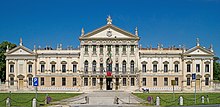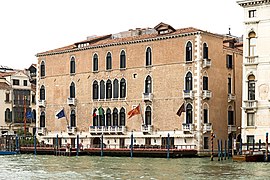Pisani family
Appearance
The Pisani family is a Venetian patrician family, originating from Pisa, which played an important role in the historic, political and economic events of the Venetian Republic during the period between the 12th and the beginning of the 18th century.
The principal male line of the family, namely the Pisanis of Santo Stefano, died out at the end of the 19th century. However, at the very beginning of the 20th century, the remaining Pisani children moved to America, where their greatgrandchildren now live.
People
- Niccolò Pisani, (1324–1380), Venetian admiral, renowned for his victories in the third war between the feuding republics of Venice and Genoa (1350–55)
- Alvise Pisani (1664–1741), 114th Doge of the Republic of Venice
- Francesco Pisani, cardinal of the Catholic Church appointed by Pope Leo X
- Count Victor Pisani, interpreter to The Final King of Italy
- Luigi Pisani, 16th-century Italian prelate
- Vettor Pisani, 14th-century admiral of the Venetian fleet
Villas

Many villas in the Veneto region were built, commissioned and owned by the Pisani family, including:
- Villa Pisani, also known as La Nazionale, situated in Stra (1721)
- Villa Pisani, situated in Montagnana and designed by Andrea Palladio (c. 1552)
- Villa Pisani, situated in Lonigo in the frazione of Bagnolo and designed by Andrea Palladio (1544)
- Villa Pisani, also known as Rocca Pisana, situated in Lonigo and designed by Vincenzo Scamozzi (1576)
- Villa Pisani Bolognesi Scalabrin, situated in Vescovana
Palaces
Many palaces in Venice were owned by the Pisani family, including:
- Palazzo Pisani a San Stefano - massive palace in the campo near the Ponte dell'Accademia, housing a conservatory.
- Palazzo Pisani Gritti, situated in the San Marco district and facing on the Grand Canal
- Palazzo Pisani Moretta, situated in the San Polo district and facing on the Grand Canal
-
Palace Pisani Gritti in Venice
-
Palace Pisani Moretta in Venice


